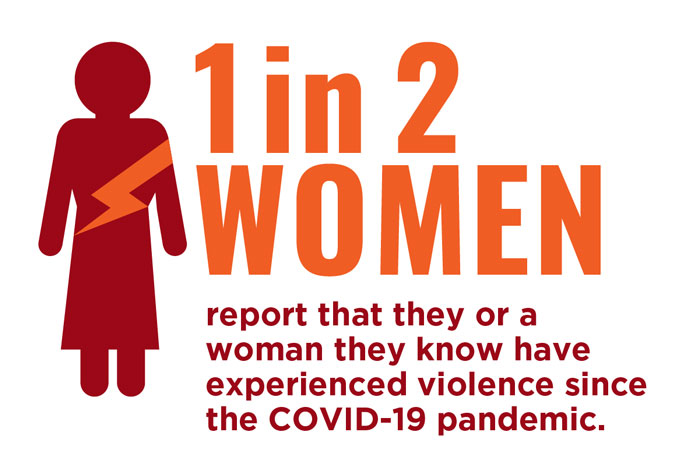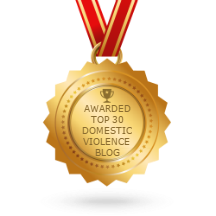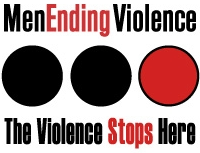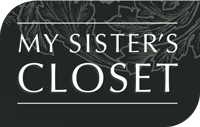For the past forty years, Battered Women’s Support Services (BWSS) has been on the frontline taking action to prevent gender-based violence (GBV).
Gender-based violence is defined as violence that is inflicted upon a person due to their gender identity, gender expression, or perceived gender.
Each year we commemorate Prevention of Violence Against Women Week held during the third week of April.
During Prevention of Violence Against Women Week, we engage our communities in GBV education, and to remind each other that we all have a role to play in preventing gender-based violence in our relationships, in our community, and in our society.
Rising Rates of Gender-Based Violence
One in three women worldwide experience physical or sexual violence, mostly by their intimate partner. Since the outbreak of COVID-19, international data has shown that gender-based violence, particularly domestic violence, has intensified and become a shadow pandemic.

Source: UN Women
Despite our efforts to bring attention to increasing gender-based violence in British Columbia and Canada, our political leaders have ignored gender-based violence as an everyday reality for women, girls, 2SLGBTQIA+, trans, and non-binary survivors.
Some key statistics on gender-based violence in Canada:
Women are over-represented as victims of gender-based violence, with women in Canada being six times more likely than men to have been sexually assaulted by an intimate partner in their lifetime. One-third (33 percent) of women in Canada have been sexually assaulted at some point since age 15, and 45 percent of women in Canada have been physically or sexually assaulted in their lifetime.
For five consecutive years, rates of reported family violence and intimate partner violence have both been increasing across Canada. In 2021, 79 percent of victims of intimate partner violence were women and girls, and, in the same year, there was an alarming 19 percent increase in intimate partner sexual assaults, compared with 2020.
Home is often the most dangerous place for women, with 87 percent of gender-related homicides of women and girls occurring at a residence. Between 2011 and 2021, the largest proportion of gender-related attempted murders of women and girls occurred at residential locations, involved the presence of a weapon, and resulted in physical injury.
Femicide is also on the rise across Canada. Femicide is the most extreme form of violence on the GBV continuum and is defined as the intentional killing of women, girls, and non-binary people explicitly motivated by and because of gender. In 2022, 184 women and girls were violently killed, primarily by men. According to the Canadian Femicide Observatory for Justice and Accountability, this represents an alarming 27 percent increase when compared to 2019. Over the past five years, over 850 women and girls were killed in Canada. That means, on average, at least one person every two days in Canada is killed due to their gender.
In the past 11 years, two-thirds (66 percent) of gender-related homicides were perpetrated by an intimate partner, 28 percent by a family member, 5 percent by a friend or acquaintance, and 1 percent by a stranger. In this same time period, the largest proportion of gender-related homicides was by stabbing. In 2021, 90 homicide victims were killed by an intimate partner, of whom 76 percent were women and girls. In the same year, the rate of gender-related homicide was more than 5 times greater in rural areas compared to urban areas.
Yet, women, youth, and children fleeing domestic, intimate partner, and/or family violence face huge barriers to safety.
According to recent data from BC Society of Transition Houses Census Survey, over a 24-hour period in 2022, at least 571 women, youth and children across BC who are unsafe in their homes were unable to access life-saving Transition Housing Programs and PEACE Programs. Even for those who can access a transition house for the 30-day period, many end up returning to their abusive partners because of the lack of long-term, affordable housing options.
The intersection of poverty, gendered violence, and lack of affordable housing is thus a key and urgent site of intervention in the struggle to end gender-based violence.
Gender-Based Violence Impacts Survivors Differently
“The goal of a feminist intersectional analysis is to understand power relations and systems of power that create barriers to women’s equality so we can work to remove those barriers and redistribute power equitably.” – Canadian Research Institute for the Advancement of Women
While most GBV data is not disaggregated, we know that GBV is completely intertwined with settler-colonialism, anti-Blackness, racialization, systemic poverty, gender identity, sexual orientation, ableism, citizenship status, and state violence. Multiple forms of oppression are simultaneous and cannot be separated from another.
Indigenous women, Black women, racialized women, newcomer immigrant/refugee women, low-income women, women with disabilities, and trans and two spirit people endure GBV at a quantitatively higher rate, and also experience GBV qualitatively differently.
At least 28 percent of victims of femicides in Canada in the past five years were racialized.
Existing Canadian data specifically suggests that the prevalence of intimate partner violence among Black women is disproportionately higher (42 percent) when compared to the total visible minority population (29 percent), yet Black women face consistent barriers to safety and justice due to pervasive misogynoir.
In Toronto, for example, 23-year-old Daniella Mallia was shot dead by her ex-boyfriend Dylon Dawson, who had been threatening and harassing her. A Toronto police officer Const. Anson Alfonso is now facing several police misconduct charges for failing to properly investigate Daniella’s reports and pleas for help.
Gender, sexuality, disability, and immigration status also amplify experiences of gender-based violence.
According to Canada’s first national report on the health and safety of racialized trans and non-binary people, 49 percent of racialized trans and non-binary respondents said they had experienced sexual harassment, and 1 in 3 reported being sexually assaulted. Survivors with disabilities also face compounding violence: women with a disability are four times as likely to be sexually assaulted than women living without a disability. For survivors without full immigration status, gender-based violence and immigration status converges into “immigration-related abuse,” where a survivors’ “immigration status not only heightens her vulnerability to violence but it can also exacerbate the nature of the violence she experiences.”
Gender-based violence is especially pronounced for Indigenous women, girls, trans and two spirit people resisting gendered colonial violence.
At least 19 percent of femicides in Canada in 2022 were of Indigenous women, despite Indigenous women comprising only 5 percent of the female population in Canada. Indigenous women are twice as likely to experience sexual abuse by intimate partner in their lifetime, about six in ten Indigenous women have experienced some form of intimate partner violence in their lifetime (as compared to 44 percent of non-Indigenous women), and LGBTQ2S+ Indigenous survivors and Indigenous survivors with disabilities have some of the highest rates of intimate partner violence in Canada.
In 2022 alone, Indigenous women and girls including Tatyanna Harrison, Noelle O’Soup, Carmelita Abraham, and Chelsea Poorman have all been murdered or died under suspicious circumstances in B.C. “Reclaiming Power and Place: The Final Report of the National Inquiry into Missing and Murdered Indigenous Women and Girls” makes clear that violence against First Nations, Inuit, and Métis women, girls, two spirit, and gender diverse people in Canada stems from targeted colonial gendered violence, emphatically stating that “The National Inquiry into Missing and Murdered Indigenous Women and Girls finds that this amounts to genocide.”
Gender-Based Violence is Preventable
Decades of GBV advocacy has culminated in the collaborative A Report to Guide the Implementation of a National Action Plan on Violence Against Women and Gender-Based Violence.
With this report, governments at all levels now have the definitive answer to the question: What will it take to achieve a Canada free of gender-based violence?
From income security and decent work to housing and childcare, from safety supports for survivors and transforming legal systems to realizing Indigenous rights and trans liberation, we know that gender-based violence can end across these lands.
And that is why we remain on the frontlines, tirelessly working every day to prevent and combat gender-based violence.




